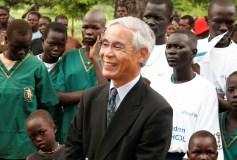Japanese envoy inspects progress of education in South Sudan
July 10, 2007 (RUMBEK) — Japanese Ambassador to Sudan, Yuichi Ishii, has seen first hand the progress being made in education in Southern Sudan with the support of Japan, the UNICEF said on Monday.
 Ishii spent three days visiting remote villages in the region where new primary schools have been constructed through a partnership between the Government of Southern Sudan, Japan and UNICEF.
Ishii spent three days visiting remote villages in the region where new primary schools have been constructed through a partnership between the Government of Southern Sudan, Japan and UNICEF.
“Our contribution is a small part of the education programme of the Government of Sudan,” said Ambassador Ishii at an official ceremony held in Rumbek, the capital of Lakes State. “We are very happy to be part of the rebuilding of this country and promotion of education is part of the rebuilding process.”
The Japanese government has contributed US$ 8.6 million to the Child-Friendly Schools Project under the Programme of Cooperation between UNICEF and the Government of Southern Sudan. These funds have enabled 20 permanent schools to be constructed and 19 others rehabilitated. The Japanese contribution was also used to procure 350,000 sets of textbooks, benefiting 750,000 schoolchildren.
“Education is one of the peace dividends that the people in Southern Sudan have gained since the signing of the Comprehensive Peace Agreement two years ago,” said UNICEF Sudan Representative Ted Chaiban, who accompanied the Japanese Ambassador in his visit to the schools.
More than two decades of civil war devastated education in Southern Sudan. Of the 3,100 learning spaces, only 16 per cent are in permanent buildings. One school in four has chairs and desks. Half of these have furniture only for teachers.
During the civil war, only one girl out of every hundred was estimated to finish primary school. The lack of appropriate school structures and separate sanitation facilities has been identified as a major factor that keeps girls out of school.
With UNICEF support, the Government of Southern Sudan launched the ‘Go to School Initiative’ in April 2006. The Initiative is a major campaign to rebuild the school system and get 1.6 million children into school. Approximately 850,000 children, 34 per cent of them girls, were enrolled in schools by the end of 2006, a major increase from an estimated 343,000 during the war.
(ST)
